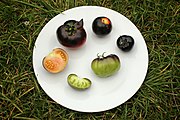Blue tomato

Blue tomatoes, also called purple tomatoes, are
ultraviolet radiation
. Some of these tomatoes have been commercialized under the names "Indigo Rose" and "SunBlack".
Conventional breeding
While tomatoes have the genes for producing
anthocyanins, these genes are typically not expressed in the fruit in most commercial varieties. The result is that the pigments are limited to leaves and stems, where they are not eaten. As of the 2012 growing season, Oregon State University developed blue tomato seeds became commercially available under the cultivar name "Indigo Rose". The blue color is produced mostly by the anthocyanin petunidin on the outside of the tomato where the fruit is exposed to direct sunlight.[1] The shaded side of the fruit is green when unripe, red when ripe, and the inside is red or deep pink. The tomatoes are small, about 2 inches across, round, and grow in clusters of 6 to 8. Flavor is described as slightly acidic. The vines are said to be indeterminate but compact, and disease resistant. While the concentration of anthocyanins is still very low compared to other fruits like blueberries, the pigments do improve the resistance of the fruits to the fungus Botrytis cinerea.[2]
Biotechnology
Purple tomatoes have been developed at the
genetic modification (GM), incorporating genes from snapdragons to increase the anthocyanin levels in the flesh of the tomatoes.[3][4] While both the conventionally-bred and the engineered varieties exhibit altered expression of the same transcription factor of the MYB gene class which controls the anthocyanin biosynthesis, the engineered variety additionally produces the pigments in the flesh of the fruit rather than just the skin.[5] This results in almost 100-fold higher concentration of anthocyanins in the engineered fruits compared to the conventional varieties.[6] The inventors of the GM purple tomato, Jonathan D. G. Jones and Cathie Martin of the John Innes Centre, founded a company called Norfolk Plant Sciences to commercialize the purple tomato.[7][8] In 2014, it was announced that they had partnered with a greenhouse farm in Canada to grow purple tomatoes from which to create new commercial products,[9] but no further announcements were made. In September 2022, the Norfolk Plant Sciences Purple Tomato received USDA approval for distribution in the United States.[10]
Difference from black cultivars
Many other tomato cultivars have names indicative of their dark color, such as
beta-carotene and lycopene
, produces a brown or black color.
Additional images
References
- ^ "The Purple Tomato FAQ | Department of Horticulture | Oregon State University". horticulture.oregonstate.edu. 2 May 2012. Retrieved 2017-12-12.
- PMID 24102530.
- PMID 19359211. Archived from the original(PDF) on 2011-07-22.
- ^ "Purple tomato 'may boost health'". London: BBC News. 2008-10-26.
- PMID 20674465.
- S2CID 14895646.
- ^ "About Norfolk Plant Sciences". Norwich: norfolkplantsciences.com. 2 May 2012. Archived from the original on 2016-03-04.
- ^ Shukman, David (2014-01-24). "GM Purple Tomatoes heading for the shops". London: BBC News.
- ^ John Innes Centre 25 January 2014 Press Release: Bumper harvest for GM purple tomatoes
- ^ Galler, Grace (12 September 2022). "New Food". Retrieved 10 January 2023.
- .
Wikimedia Commons has media related to P20 Blue (tomato).


